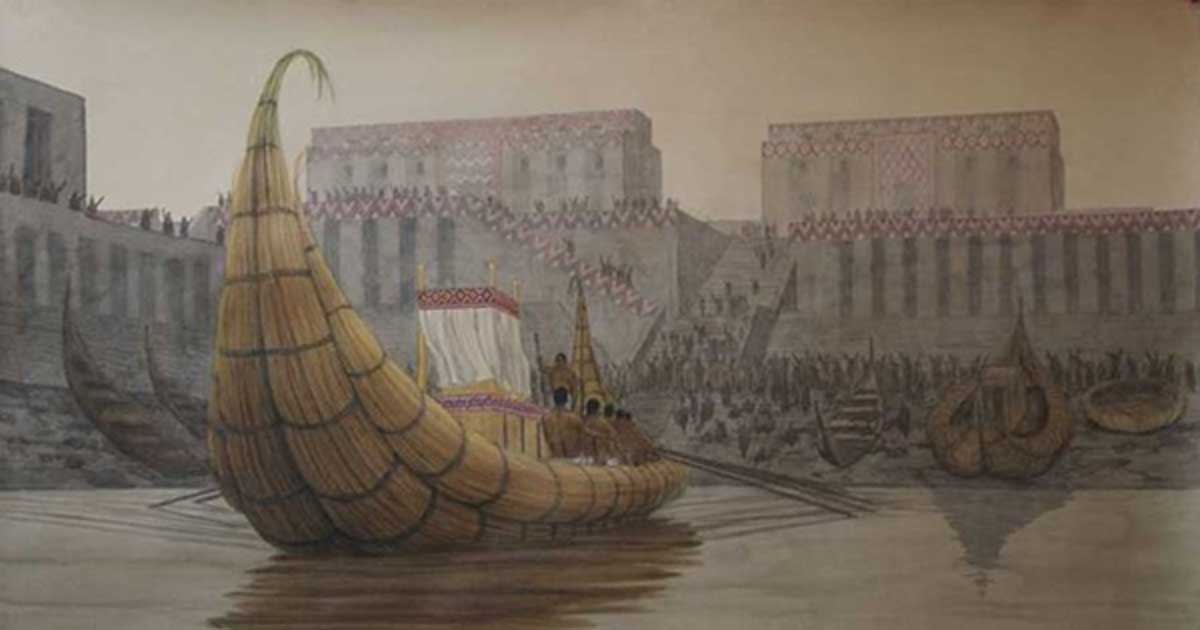What Was Life Like in Sumer, History’s First Civilization?
Life went through some incredible changes when the first cities were built. Up until then, nearly every person had to work as a farmer or a hunter, moving from place to place in a constant struggle to survive.
All that changed about 7,000 years ago, when Sumer, the first civilization, began. For the first time in human history, people moved into the safety of a walled city. For the first time, they didn’t have to hunt or farm. They could become builders, astrologers, and teachers. They could develop things that, until then, no one had ever even dreamed of.
It was the dawn of history; the greatest change humans have ever undergone.
What must it have been like? What was it like for the first people who put aside their farms and their hunting tools and moved into the first cities? And how different was it from life today?
- Sip Like a Sumerian: Ancient Beer Recipe Recreated from Millennia-Old Cuneiform Tablets
- From Sumerian Gods to Modern Day: The History of Slavery
- Was Bolivia-Peru the Sunset Land of the Sumerians?

Artist's impression of prehistoric hunters. ( We Have Concerns)
It’s impossible to say for sure what they experienced, but in the ruins of the first cities, there are a few hints. Archaeologists and historians have scoured over the remains of Sumer to give us a glimpse into life in mankind’s first civilization.
Life Revolved Around the Temple
The first cities started as temples to the gods. They were built around a temple and run by priests called “Ensi” who ran religious services and acted as kings to the people who lived near them.
They were religious centers through-and-through. The first people likely moved in to be close the temples of their gods; there wouldn’t have been a non-believer among them. They were expected to make an offering before setting up their homes, and they had to contribute a part of what they grew to the temple.

Statuette of a Sumerian worshipper from the Early Dynastic Period III. (Luis García/CC BY SA 3.0)
As the communities around these temples grew, though, their purposes changed. The first shops and trade networks were set up in the courtyards of the temples, and the first secular jobs were created. Some of the elite left their farms and became professional traders, seamstresses, artists, and messengers.

Reconstruction of the Ziggurat at Ur. (Public Domain)
Beer and Taxes
The priest-kings set up an early system of taxation to feed their workers. Every family living within the protection of the city had to contribute a part of what they grew to the temple. The temple would then use what they’d earned to feed their priests, their craftsmen, and their traders.
Beer was usually how people were paid. In Sumer, beer wasn’t just a way to get a drunk. It was as thick as a milkshake and loaded with nutrients. More often than not, it would be served as the main course of a meal. That it got you drunk was just an added bonus.

The oldest depiction of beer-drinking shows people sipping from a communal vessel through reed straws. (Brauerstern)
The other way the temple would tax you was to call you in to work on public building projects. People would be called out of their homes and forced to spend a few months upgrading the temple or building new city walls. And soon, through the power of conscripted labor, these cities became the safest places on earth.
Life Inside and Outside the City Walls
The city walls served two purposes. Ostensibly, they were a way to keep the people safe. They protected them against the neighboring cities, where warlords were starting to wrestle power from the priests and invade their neighbors. But in practice, they also served a second purpose. They made a thick, clay wall that divided the rich from the poor.
The most powerful men were those who didn’t grow their own food. They were the priests, the craftsmen, the administrators, and the traders who lived off the taxes gathered from the poor.
They lived in homes made out of mud bricks, designed to keep them cool through the blistering Sumerian summers. They had slaves and hired entertainers who would come into their homes and sing them songs or tell them stories while the family feasted.
But on the outside were the farmers. They spent their days tilling the soils and growing their crops, then came home to a hut made out of reeds tied together in tight bundles. They slept on mats of woven straw on the floor, and when it got cold, they burned palm fronds in a shallow pit in the middle of their huts.
The Beginning of Education
Life could change at any moment. The lowliest farmer could work his way up to the top as long as he was willing to work hard enough.
The farmers owned their land, and if they worked hard enough, they could buy more. Then they could sell their land out to others at a profit and grow even wealthier. Steadily, they could work their way up to a place inside the city walls.
Literacy was the best way in. As the Sumerians started to trade, tax, and hire workers, they found a need to keep track of everything they’d done. They developed the first written language, cuneiform. Reading and writing became the key to being an administrator, and the first schools were built.
Learning cuneiform, though, wasn’t easy. It took twelve years in school, starting at the age of seven, for a boy to learn everything he needed to know to become a scribe or a priest. He would work from dusk to dawn copying down what his teacher wrote on a tablet, and he’d often get beaten if he made a mistake.

The oldest depiction of beer-drinking shows people sipping from a communal vessel through reed straws. ( Brauerstern)
The very wealthy would hire private tutors to keep teaching their children even after the classes ended. A noble boy who learned enough could become a priest, and that would make him one of the most powerful men in the city. Sumerian parents were willing to sacrifice everything to get their children to the top.
- 4,000-Year-Old Sumerian Port Shows the Famed Civilization Excelled at Sea Too
- Leaving an Impression: Revealing the Intricate Story of Sumerian Cylinder Seals
- Tamils and Sumerians Among the FIRST to Reach Australia and Antarctica? PART I
Social Status
In practice, though, it was very difficult to change your status. The schools were prohibitively expensive, and so it was very rare that anyone could move up in social standing. While a few living inside the city walls managed to turn their children into priests, there’s no record of anyone on the outside ever successfully moving in.
And if things went poorly, they could get a lot worse. If a family built up enough debts, they could be forced to sell their children into slavery. And if they still couldn’t make their payments, they could be dragged into slavery themselves.

Worker using an adze for cutting a piece of a chariot. Terracotta relief, early 2nd millennium BC. From Eshnunna. (Marie-Lan Nguyen/CC BY SA 2.5)
Still, some made it. Some who became slaves managed to earn enough to buy their own freedom. And some commoners rose all the way to the top. One woman, named Ku-Baba, started life as a tavern keeper and, in time, became to supreme ruler of a town called Kish.
Above all, though, they got the chance to be part of one of the greatest experiments in human history. Within their city walls, the first written language was created, the first trading routes were built, and the first laws were established. They were to witness the birth of civilization.
Top Image: Re-creation of the port at the Sumerian city of Eridu. Source: Public Domain
By Mark Oliver
References
“Daily Life of Mesopotamian Commoners.” History on the Net. Regnery Publishing. https://www.historyonthenet.com/daily-life-of-mesopotamian-commoners/
“Mesopotamian Priests and Priestesses.” History on the Net. Regnery Publishing. https://www.historyonthenet.com/mesopotamian-priests-and-priestesses/
“Mesopotamian Education and Schools.” History on the Net. Regnery Publishing.
https://www.historyonthenet.com/mesopotamian-education-and-schools/
“Sumer: The First Mesopotamian Culture.” History on the Net. Regnery Publishing. https://www.historyonthenet.com/sumer-the-first-mesopotamian-culture/




















Comments
Sumer was most likely similar to the ruins of the Indus Valley, where later inhabitants laid mud bricks overtop megalith stone ruins. The most ancient Sumer texts speak, in celebratory fashion, of the founders making a well from mud bricks, which of course do not survive the ages like megalith stone. The texts make NO mention of quarrying, cutting, moving and stacking the megalith stones, or carving out the subterranean caverns that better served as living spaces in that climate. Of course the pre-historic “stone age” civilization (master stone masons?) that existed prior to the resettlement of their destroyed cities is always ignored. So we have to ask, what happened to them?
Nobody gets paid to tell the truth.
The Oriental Institute have published videos on this for the Egyptian Civilisation that are also very interesting and seem to have been setup on very similar lines.
https://www.youtube.com/watch?v=K2CcicIsths (death and taxes)
The beer was a safe way of consuming water and provided useful nutrition another video on this from the British Museum with some beer makers. https://www.youtube.com/watch?v=izpoexYN1-8
Guillaume, Excellent comment...
Charles Bowles
I agree with Charles, as I live there, about 100Km directly inland from Cape Aghulas.
It is the current paradigm that says Sumer was the first city not the reality
Mark, why would getting drunk be an added bonus? Drunks make total arses of themselves, generally.
I doubt if Sumer was the first civilization of cities, especially depending on what one would consider the definition of a city. the first real cities occurred in the southern part of the African continent...
Charles Bowles